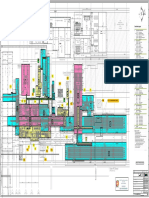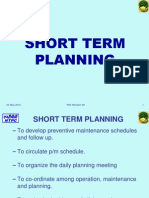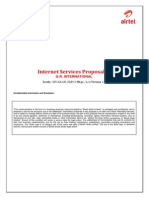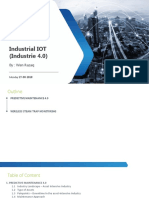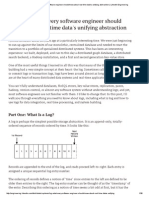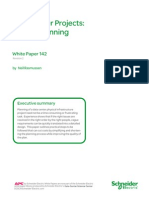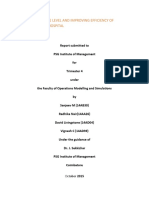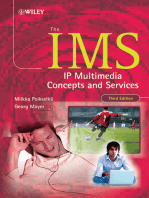Project Case Study of Spare Part Management System (1) ..
Uploaded by
Vipul SharmaProject Case Study of Spare Part Management System (1) ..
Uploaded by
Vipul SharmaSpare Part Transaction Management System
PRACTICAL TRAINING REPORT AT HCL INFOSYSTEM LTD SEC 3, NOIDA
Spare Part Transaction Management System
Submitted in partial fulfillment of Bachelor of Technology degree Of the University of
Made by ::
Spare Part Transaction Management System
ACKNOWLEDGEMENT
It would be insufficient just to say a word of thanks for all those people who have been so instrumental in the success of this project. However, as a small token of our appreciation we have named here of all those wonderful people , without whom all this would not have been possible. At the very outset, we would like to express our deep sense of gratitude to our mentors at the college, Principle _______________who have been so kind to give us the necessary infrastructure. They have also been a constant source of inspiration. We are deeply indebted to our project manager at HCL, ___________ for allowing us to gain the benefits of HCL way of life It would be unthinkable for us not to say something special for our guide at HCL, ____________ who has continually helped and guided us . It is due to his efforts that our project has gained its present stature and we can never thank him enough for all he has done.
YOUR NAME
Spare Part Transaction Management System
CONTENTS
Chapter Name 1. COMPANY PROFILE 2. ABSTRACT
Page No. 4-5 6
3.
INTRODUCTION AND SCOPE 7
4. PROJECT OBJECTIVES AND OUTLINES 5. PROBLEM DEFINATION AND FEASIBILITY STUDY 6. SYSTEM ANALYSIS AND DESIGN 7. IMPLEMENTATIONS 8. TESTING AND DEBUGGING 9. LIMITATIONS AND ENHANCEMENT 10. CONCLUSION 11. BIBLIOGRAPHY
8 9-10 11-37 38-40 41-43 44 46 47
Spare Part Transaction Management System
CHAPTER 1 COMPANY PROFILE
HCL Infosystems Ltd is one of the pioneers in the Indian IT market , with its origins in 1976. For over quarter of a century, they have developed and implemented solutions for multiple market segments, across a range of technologies in India. They have been in the forefront in introducing new technologies and solutions.
HCL Infosystems ( HCLI) draws it's strength from 29 years of experience in handling the ever changing IT scenario , strong customer relationships , ability to provide the cutting edge technology at best-value-for-money and on top of it , an excellent service & support infrastructure. HCL Infosystems has alliances with global technology leaders like Intel, AMD, Toshiba, Ericsson, Microsoft, Nokia and Sun Microsystems, SAP, Scansoft, SCO, EMC, Veritas, Citrix, CISCO, Oracle, Computer Associates, RedHat, Infocus, Duplo, Samsung, Novell. Today HCL is country's premier information enabling company . It offers one-stop-shop convenience to its diverse customers having an equally diverse set of requirements. Be it a large multi-location enterprise, or a small/medium enterprise, or a small office or a home, HCLI has a product range, sales & support capability to service the needs of the customer.
Spare Part Transaction Management System Last 29 years apart from knowledge & experience have also given us continuity in relationship with the customers, thereby increasing the customer confidence in us. Our strengths can be summarized as: - Ability to understand customer's business and offer right technology - Long standing relationship with customers - Pan India support & service infrastructure - Best-vale-for-money offerings Technology Leadership HCL Infosystems is known to be the harbinger of technology in the country. Right from our inception they have attempted to pioneer the technology introductions in the country either through our R&D or through partnerships with the world technology leaders. Using our own R&D we have - Created our own UNIX & RDBMS capability (in 80s) - developed firewalls for enterprise & personal system security - launched our own range of enterprise storage products - launched our own range of networking products We strive to understand the technology from the view of supporting it post installation as well. This is one of the key ingredients that go into our strategic advantage. HCL Infosystems has to its claim several technology pioneering initiatives. Some of them are: - Country's first DeskTop PC - BusyBee in 1985 - Country's first branded home PC - Beanstalk in 1995 - Country's first Pentium 4 based PC at sub 40k price point - Country's first Media Center PC
Spare Part Transaction Management System
As a leading information enabler, HCL Infosystems has long standing relationships with world technology leaders such as SUN for enterprise computing solutions, Intel and AMD for PCs and PC Servers; Microsoft, Novell and SCO for operating systems and software solutions; Toshiba Corp. for business automation equipment; and Oracle, Sybase and Informix for RDBMS platform, EMC, Veritas for storage solutions. The aim is to straddle the entire landscape of information enabling technology far more comprehensively, effectively and competitively
Spare Part Transaction Management System
CHAPTER 2 ABSTRACT This software package is about Spare Part Transaction Management System which runs on a personal computer. This package gives all the information regarding the transaction of spare parts & other details. It also gives the facility of adding , deleting ,modifying ,inquiry and searching of transactions performed in various ways . This package also provides facility for searching the details of a transaction of spare parts on the basis of code. Also information of various things like mode of transportation can be entered . Proper customer codes & details are also provided . This software can be very useful to the various organization, departments and big establishments for managing their routine activities of exchange.
Spare Part Transaction Management System
CHAPTER 3 PROJECT INTRODUCTION AND SCOPE
Information is what the world pivots on today . For many organization , computer organization systems are now at the heart of daily activities and a major consideration in corporate decision makings .Without computerized assistance organizations will grind to a halt,for the sheer volume of activities would overwhelm workers and manager .The development of information systems have played a dominant role in the evolution of information economy. We have selected CPP as a programming language because it has grown to be a tool of choice for most of the programmers when compared to any other programming language and has been strategically placed by Microsoft to be the corner stone of windows programming. The main objective of our project is to make reliable and efficient transaction management system ie, a system which is user friendly and at the same time powerful enough.It has the capability to keep the entire information of a transaction and to reproduce it whenever required. The project was carried out successfully at HCL INFOSYS.
Spare Part Transaction Management System
CHAPTER 4 PROJECT OBJECTIVE AND OUTLINES
Our project Transaction Management System is devised basically to keep diminutive details of customer and to retrive them whenever needed.The formalties are indeed complex. Keeping in view the requirements of the application , the basic objectives is to devise a system which incorporates the following features: Storage of data: It should be able to store data , both fixed and variable, at one place in an efficient effective style . This enables the user to access data easily. Fast data reproduction: The process involves frequent data verification ,validation, detection and correlation.Hence brisk and accurate data reproduction is essential User friendliness: It should not be user dependent.The user interface should be such that the system is as user friendly as possible.Helps should be provided. Support decision making: It should be able to generate reports on various processes and entities. The transaction and master record should be able to assist the management to take relevant decisions These points constitute the basic framework under which our project had to be developed.
Spare Part Transaction Management System
CHAPTER 5 PROBLEM DEFINITION AND FEASIBILITY STUDY
Statement about the Problem: - In todays fast growing population and competition among different bodies, it becomes difficult to manage each activity manually. The same is applicable on institutes also where now a days so many activities are performed and to keep track of each activity manually is difficult as it takes a lot of time and it generated a lot of errors, so the client wanted to computerize this task for getting faster and error free results. So, to overcome this problem automation of the system is required. With this automated system we can very well manage the different activities going on in a system. System Study:- The system study is a study of the operations of a set of connected elements and of the inter-connections between these elements. It consists of system analysis and system approach. The system approach shows a set of procedure for solving a particular problem; and system analysis is a management technique, which helps us in designing a new system or improving the existing system. System/Subsystem:- This system processes the information, also it processes various activities going while transaction. This information can be readily used for transactions or inventory listing and modify that information if there is any drawback. End User :-The end user of this system is going to be receptionist . FEASIBILITY STUDY PLATFORM REQUIREMENTS:-
10
Spare Part Transaction Management System
HARDWARE REQUIRED: IBM or compatible computer with a 486 . 1. One high density Floppy Disk drive or CD-ROM player. 2. One Hard-Disk . 3. A Printer is required for printing transaction details(laser or inkjet preferred) 4. A mouse. 5. A CGA Color Monitor. 6. A Keyboard for data entry.
SOFTWARE REQUIRED:1. Windows 98/2000/XP operating system. 2. Ms Dos Prompt 3. Microsoft Word or Notepad (as back end). ECONOMIC FEASIBILITY(Cost Benefit Analysis):The system that can be developed must be profitable for the organization. The primary objective of cost benefit analysis is to find out whether the proposed system is worthwhile to invest in. Financial benefits must be equal to or greater than the costs. If the returns on the investment I good then the project is considered economically worthwhile. Cost benefit analysis should be done before preparing the proposed system. First all the cost associated with the proposed project should be evaluated. Conceptually, the cost of project represent all the items of outlay associated with the project which are long term funds. It is the sum of outlays of the following: Land and site development Machinery. Manpower. Technical feasible system is always accurate, reliable , and secure so that this feasibility is a most required feature of a system. The developed system is technically sound. It can work on simple personal computer its hardware and software requirement and produce output within a given limited time. It has ability to process small volume of transaction at speed and provide a great friendly environment to user. 11
TECHNICAL FEASIBILITY:-
Spare Part Transaction Management System
CHAPTER 6 SYSTEM ANALYSIS AND DESIGN
This chapter covers the following topics : 1. 2. 3. 4. 5. Introduction. System Characteristics. System Elements. System Analysis. System Development Strategies. a. System Development Life Cycle Method (SDLC). b. Structured Analysis Development Method (SADM). c. System Prototype Method (SPM). 6. 7. The Three Strategies compared. System Development Tools.
Introduction : System analysis and design refers to the process of examining a business situation with the intention of improving it through better procedures and methods. It basically focuses on systems, processes and technology. This chapter discusses the system concepts, its characteristics, its tolls, its analysis, design and the system development tolls.
12
Spare Part Transaction Management System A system is simply a set of components that interact to accomplish some purpose. It exists because it is designed to achieve one or more objectives. There are two types existing : An open system has many interfaces with its environment. It permits interaction across its boundary; it receives from and delivers outputs to the outside. An information system is the means by which data flows from one department to another. In contrast, a closed system is one, which is associated with any environmental influences. In reality, a closed system is rare. System Characteristics : The systems purpose is its reason for existing. Some of its major characteristics are : ORGANISATION : Organisation implies structure and order. It is the arrangement of components that helps to achieve objectives. In any business system, the hierarchical relationships represents the organisation's structure. INTERDEPENDENCE : Interdependence means the parts of the organisation or computer system that depends on the input of another and vice versa. INTEGRATION : Integration is concerned with how a system is tied together. It means the parts of the system work together within the system though each part performs a unique function. Integration produces a synergistic effect and greater total impact. CENTRAL OBJECTIVE : Any company stating a goal and working for another may finally not achieve it's goal, hence the central objective of any company should be well defined and work should be done in order to achieve it. System Elements : In a dynamic environment, in order to reconstruct a system, the following system elements must be considered. INPUTS AND OUTPUTS : A major objective of any system is to produce an output that has value to its user. This output is the first step in specifying the nature, amount and regularity of the input. Inputs are the elements for processing.
13
Spare Part Transaction Management System PROCESSOR (S) This is the element of a system that involves that actual transformation of input into output. It is the operational component of a system. CONTROL : The control element guides the system. This is the decision-making sub-system that controls the pattern of activities governing input, processing and output. FEEDBACK : Feedback measures output against a standard. Its useful in achieving control in a dynamic system. Feedback could be positive or negative. ENVIRONMENT : It is the supra system within which the organisation operates. It's the source of external elements that impings on the system. BOUNDARIES AND INTERFACE : Every system has boundaries that determine it's sphere of influence and control. System Analysis: System Analysis, is the process of gathering and interpreting facts, diagnosing problems and using the information to recommend improvements to the system. The system analysis performs this job. Analysis specifies what the system should do. It is about understanding situations, not solving problems. The system development life cycle method is generally used to determine the appropriate information. System analysis can also be said to be fact finding followed by analysis of the fact. One aspect of analysis is defining the boundaries of the system and determining whether or not a candidate stem should consider other related systems. Data are collected on the available files, decision points and transactions handled by the present system. Tools used are data flow diagrams, interviews, on-site observations, questionnaires, etc. System Development Strategies : Computer Information systems serve many purposes randomly from processing of business transactions to providing suggestions needed to make decisions. In some instances, the factors to be considered for decision making can be determined in a sequential fashion. The three sequential approaches to the development of computer information systems are : System Development Life Cycle Method (SDLC) 14
Spare Part Transaction Management System Structured Analysis Development Method (SADM) System Prototype Method (SPM) This section discusses each approach, in brief, focussing on the characteristics of the method and its advantages and disadvantages. SDLC Method : The SDLC method is classically the set of activities that analysts, designers and users carryout to develop and implement an information system. The six activities that make up the SDLC are briefly examined below : 1. PRELIMARY INVETIGATION : This is the first system activity. It begins whenever a request to receive assistance from the information system is made. It has three parts : REQUEST CLARIFICATION : Before any system investigation is started, the project request must be examined to determine precisely what the originator wants. FEASIBILITY STUDY : This phase determines whether or not the project requested is feasible. Three aspects considered are : a. b. c. Technical Feasibility : Can the project be fulfilled with the current or new available data technology ? Economic Feasibility : Are the costs and benefits balanced ? Operational Feasibility : Will the system be supported by users or not ?
REQUEST APPROVAL : Any organisation will approve only those projects, which are both desirable and feasible.
2. DETERMINATION OF SYSTEM REQUIREMENTS: At the heart of system analysis is a detailed understanding of the all important facts of business under investigation. For the same, some key questions have to be asked. Questionnaires, interviews, study of manuals, reports, observations, sample collection, etc. are used to collect these answers. As the answers are collected the analysts studies the requirements and the data to identify the features needed to accomplish the next step i.e. the system design.
15
Spare Part Transaction Management System 3.DESIGN OF SYSTEM : The design of an information system provides the details that state how a system will meet the requirements identified during system analysis. This is often referred to as logical design. It describes data to be input, to be calculated or stored. Designers select file structures and storage devices, such as magnetic disks, tapes and even paper files. The design specifications are documented in charts, tables and special symbols. The detailed design is passed on to the programming staff to develop software. 4.DEVELOPMENT OF SOFTWARE : Software developers may either install purchased software or develop new software. This choice depends on the cost of each option, the time available to write software and the availability of programmers. Programmers are responsible for documenting the program, providing an explanation of how and why procedures are coded in specific ways. 5.SYSTEM TESTING : Systems testing experiments the use of the system to ensure that the software does not fail. Testing may be performed by persons other than those who wrote the original program to ensure more complete and unbiased testing which would result in acquisition of a reliable software. 6.IMPLEMENTATION AND EVALUATION : Implementation is the process of having system personnel check outs and put new equipment into use, train users, install the new application and construct any files of data needed to use it. After successful implementation, evaluation of the system is done to identify its strength and weaknesses. Operational Evaluation assesses the manner in which the system functions. The organizational impact of the system is evaluated or determined. Evaluation of the development process is performed. SAD Method : This method overcomes the difficulty of fully understanding computer systems by Partitioning the system into components. Constructing a model of the system. Structured analysis focuses on specifying what the system is required to do. Its essential elements are :
16
Spare Part Transaction Management System GRAPHICAL SYMBOL : Symbols or icons are used, instead of words to create a graphical model of the system. These present details without introducing manual or computer process, tape or disk files, programs or procedures. DATA FLOW DIAGRAMS : These show the sources and destination of data, identify the names and processes performed, identify and name the group of data elements connecting one function to another and the data they access. DATA DICTIONARY : This describes, in detail, all the definitions of elements like data flow, processes and data stores. Structured analysis utilizes the above analysis tools to lead to the specification of program modules that are functionally independent. It uses tolls like the structure chart to achieve the same. SPM Method : A system prototype is a working system. It may be used when the features of the system are partially known or when no system of the kind exists or when alternate versions of system are required. In system prototyping the steps followed are : Identify user known requirements. Develop a working prototype. Continue with enhancements and changes. Revise prototype. Repeat till satisfactory system is achieved. After sufficient information has been collected from the prototyping process, usually one of the following step is perfomed : The prototype is redeveloped. The prototype is implemented as the computed system. The project is abandoned if information foretells that the project is not feasible. Another prototyping series is begun.
Each alternative is viewed as a successful result.
17
Spare Part Transaction Management System The Three Strategies Compared : The three strategies presented above were compared and the following advantages/disadvantages were observed. SYSTEM DEVELOPMENT LIFE CYCLE : Advantages : Problem definition. Summary of the findings and recommendations. Details of findings and conclusion. Helps not only in understanding the problem but also acquiring a complete sense of its scope and estimating the complexity involved. Disadvantages : When interviewed, people may not speak out openly or may not express themselves properly. High transaction and processing volume. Requires validation of input data.
STRUCTURED ANALYSIS AND DESIGN : Advantages : This strategy is suitable for all types of applications. It is most useful as a supplement to other development methods. It leads to specification of program modules that are functionally independent.
Disadvantages : It does not specify field or database design, input or output layouts, processing sequences or the hardware required for the application to run.
18
Spare Part Transaction Management System This strategy consumes time in developing charts and diagrams, particularly if the system is complex. SYSTEM PROTOTYPE METHOD : Advantages : It is an interactive process. This strategy could be adopted when the essential features of the system are partially known, or are not identifiable even after careful analysis. The system users from different levels will participate in the development process. The development of the system can be done using conventional programming languages and methods. It is useful for testing the system feasibility, identifying the user requirements, evaluating a system design or examining applications usage. It ensures little development time, more accurate user requirements and great user participation and support. Disadvantages : All the requirements may not be known at the beginning of the analysis. Hence the prototype model may be an incomplete one. The user requirements may undergo modifications and if this occurs, the entire prototype model stands cancelled and has to be done again. To provide a system that meets the desired objectives, it may involve several modifications and redesign of the entire system, which may take a considerable amount of time. System Development Tools : A tool is any device that when used properly, improves the performance of a task. The tools for system development are grouped as :
19
Spare Part Transaction Management System 1. ANALYSIS TOOLS : These assist system analyst in documenting an existing system, and determining the requirements for a new application. These tools include : Data Collection Tools : Assists in identification and capture of the document's details of system. Charting Tools: Create graphics representation of systems and activities. Assists in data flow diagrams, icon drawings and flowcharting programs. Dictionary Tools : Record and maintain descriptions of data items, processes and data stores. It may be used to report where items are used.
20
Spare Part Transaction Management System
PROJECT RELATED ER DIAGRAMS
ENTRY
MAIN MENU NEW MODIFY DELETE INVOICE INVOIC E
NEW
MODIFY
DELETE
SEARCH
CONTROL FLOW DIAGRAM
21
Spare Part Transaction Management System
NEW
New order product or a customers information can be added
MODIFY
Enter the required code and modify the information of customer order or product 22
Spare Part Transaction Management System
DELETE
Deletes the information about product customer order or product
SEARC H
Searches information about customer , order or customer on entering the required code 23
Spare Part Transaction Management System
INVOICE
Create an invoice of the product
EXIT
Exits from the current menu
24
Spare Part Transaction Management System
PAYMENT TYPE CE ADDRESS CUSTOME R NO. SR NO. DELIEVRY NOTES
ORDER CE NAME
TRANSPORT MODE
ORDER DATE
ORDER TYPE
SIMPLIFIED ER DIAGRAM FOR ORDER ENTITY
CODE NAME
SALES TAX NO.
BILLING ADDRESS
DELIVERY ADDRESS
CUSTOMER
CUSTOMER TYPE
SIMPLIFIED ER DIAGRAM FOR CUSTOMER
25
Spare Part Transaction Management System
PRODUCT CODE
CURRENT STOCK MONTH
DESCRIPTION RATE
PRODUCT MONTH OPENING STOCK
SIMPLIFIED ER DIAGRAM OF PRODUCT ENTITY
LOGIC FLOW CHART:: (next page)
26
Spare Part Transaction Management System
START
e y k g t l
MAIN MENU 1.New Order 2.Customer 3.Product 4.View Order 5.Generate Invoice 6.Delete Order
Enter choice
If choice = new order
If choice= custom er
If choice = product 27
Spare Part Transaction Management System
If choice = View order
If choice = generate invoice
If choice = delete order
STOP
Enter details
Automatic generation of code
New order created 28 e
Spare Part Transaction Management System B
Main menu (customer) 1.add 3.view 2.modify 4.delete 3 Enter choice
m n o p
If choice = add
If choice = modify
If choice = view order
If choice = delete
29
Spare Part Transaction Management System B
Main menu (customer) 1.add 3.view 2.modify 4.delete 3 Enter choice
m n o p
If choice = add
If choice = modify
If choice = view order
If choice = delete
30
Spare Part Transaction Management System
Enter the details
Code is created
New product is added
C f Main menu(product) 1.add 3.view 2.modify 4.delete 3 Enter choice
f g h i
If choice = add
If choice = modify 31
If choice = view order System
c Spare Part Transaction Management
b If choice = Product code delete d
Select option to modify k
Modify product created g
32
Spare Part Transaction Management System
Enter the code
Product information display
Enter the code
Delete the product
33
Spare Part Transaction Management System
Enter the serial no
Searching performed
Enter all the details
Automatic generation of code
34
Spare Part Transaction Management System
Enter the sr no
Deletion performed
35
Spare Part Transaction Management System
Enter the details
Code is created
New customer is added m
customer code
Select option to modify
Modified customer created n
36
Spare Part Transaction Management System
Enter the code
Customers information is displayed
Enter the code
Delete the customer
37
Spare Part Transaction Management System
CHAPTER 7 IMPLEMENTATIONS
This chapter covers the following topics : The implementation of the front end 1. Introduction 2. Case Study 1: Main Form Conclusion
Transaction (customer,product,order) : -This is used to store and retrieve all the details regarding the customer product and order .These details include the Customer code,ce name, transport mode,area,payment type, address, . etc. The customer code,sr no,product code are the primary keys and are also the key to the successful operation of the entire system. Their cannot exist customers having the same customer code ie, no duplicacy. IMPLEMENTATION OF FRONT END Introduction:- The front end which was created using CPP consisting of several forms with elegantly designed user interfaces to understand the front end thoroughly we take Customer ,Product, Order details as a case study since it is undoubtedly the life line of the system. The NEW ORDER :- This is argue ably the most important mode. This mode was designed to enter the information related to order. The sr code will be generated automatically. New order created will be stored in the database. information can be deleted ,added, and modified
38
Spare Part Transaction Management System class order { int ono; date od; char odtype; long int custno; char consname[20]; char consadd[30]; char mot; char paytype[4]; char delinstruct; int n; long int prcode[8]; char prodesc[8][15]; long int ordqty[8]; long int allqty[8]; long int serqty[8]; char odstat; public: void ord_det(); void allocate_stock(); void disp_ord(); int get_ono(); date get_odate(); long int get_custno(); char *get_con_name(); char *get_con_add(); char get_mot(); char *get_ptype(); char get_dins();
39
Spare Part Transaction Management System int get_noi(); long int get_pcode(int i); char *get_pdesc(int i); long int get_aqty(int i); };
CUSTOMER:. This mode was designed to enter the information related to customer no. The customer code will be generated automatically. New customer created will be stored in the database. information can be deleted ,added, and modified class customer { long int ccode; char cname[25]; char deladd[40]; char billadd[40]; char custotype; float discount; long int stno; public: void cadd(); void cview(intr); void mod_cust(long int ccd); long int rcode(); long int rstno(); void disp_cust(); };
40
Spare Part Transaction Management System PRODUCT: This mode was designed to enter the information related to product code. The product code will be generated automatically. New product created will be stored in the database. information can be deleted ,added, and modified class product { long int pcode; char pdesc[15]; int prate; long int cstock; int month; int mo_stk; public: void add(); void view_all(int r); void disp_prd(); void reduce_cstock(long int stk); long int rpcode(); char *rpdesc(); long int get_cstock(); float get_prate(); void mod_prd(long int pcd); };
41
Spare Part Transaction Management System
CHAPTER 8 TESTING AND DEBUGGING
TESTING OBJECTIVES: Testing is a process of executing a program with the intent of finding an error. A good test case is one that has a high probability of finding an as-yetundiscovered error. A successful test is one that uncovers an as-yet-undiscovered error.
TESTING PRINCIPLES: All tests should be traceable to customer requirements. Tests should be planned long before testing begins. Testing should begin in the small and progress toward testing in the large. Exhaustive testing is not possible. To be most effective, testing should be conducted by an independent third party.
METHODOLOGY USED FOR TESTING: WHITE BOX TESTING: It is a test case design method that uses the control structure of the procedural design to derive test case. We have used White Box Testing method in all our modules Checked that all the loops are working in their operational bounds. The data types of the variables have been checked and there is no miss match in data type i.e., suppose ans is varible whose data type is string then it is storing text data only not the numeric or integer data.
42
Spare Part Transaction Management System All the conditions have been properly checked and the necessary actions have been taken accordingly. All the independent paths within a module have been exercised at least once. Example If there are some statements written after If-then-else endif condition then they all will be executed once in a module but the statements written in ifendif block they will be executed only when the condition is met. CONDITION TESTING: It is a test case design method that exercise the logical conditions contained in a program module. A simple condition is a Boolean variable or a relational expression , possibly preceded with one NOT( ~) operator. If a condition is incorrect, then at least one component of the condition is incorrect. Therefore, types of errors in a condition include the following: Boolean operator error(incorrect/missing/extra boolean Operator). Boolean variable error. Boolean parenthesis error. Relational operator error. Arithmetic expression error.
LOOP TESTING: Loop testing is a white box testing technique that focuses exclusively on the validity of loop constructs. Four different classes of loops can be defined : Simple loops: -The following set of tests can be applied to simple loops, where n is the maximum number of allowable passes through the loop. 1) Skip the loop entirely. 2) Only one pass through the loop. 3) Two passes through the loop. 4) m passes through the loop where m<n. 5) n-1, n , n+1 passes through the loop. Nested Loops:- If we were to extend the test approach for simple 43
Spare Part Transaction Management System loops to nested loops, the number of possible tests would grow geometrically as the level of nesting increases. -- Start at the innermost loop. Set all other loops to minimum values. -- Conduct simple loop tests for the innermost loop while holding the outer loops at their minimum iteration parameter(eg loop counter) values. Add other tests for out-of-range or excluded values. -- Work outward, conducting tests for the next loop, but keeping all other outer loops at minimum values and other nested loops to typical values. Concatenated loops Unstructured loops
All the looping structure in different modules have been tested in accordance with the methods described above. BLACK BOX TESTING: Black Box Testing, also called behavioral testing, focuses on the functional requirements of the software. Black Box testing attempts to find error in the following categories: 1) Incorrect or missing functions: Suppose we have to format the date data type as per to our requirement and for that we write the format function. Now if we use this function in our module then we have to write this function correctly and also we have to provide the correct arguments to the function for its right execution. 2)Interface errors: If there are some errors in interface then they can be checked by Black Box Testing. 3)Errors in data structures or external database access: If the incorrect database name is provided to the DAO(data access objects) variable or object then it will result in external database access error. 4)Behavior or performance errors: Such errors also can be checked by the Black Box Testing.
44
Spare Part Transaction Management System 5) Initialization and Termination errors: Black Box Testing can test abnormal termination of the program. Also if there are some variables, which are unintialized, then they can be traced under Black Box Testing. The source code have been tested in accordance with the methods described above.
CHAPTER 9
LIMITATIONS AND ENHANCEMENT OF THE PROJECT:-
Our project has few limitations which are to be overcomed in the near future. Some of them are:1. Project is meant for small scale establishments ie, customer name starting with the same alphabet should not exceed 1000. 2. All entries in the main form are to be completely filled. 3. Records of the customer are not in a sorted manner.
In the near future the project can be further enhanced to include a multitude of features. These extensions can be incorporated into the project to improve the overall performance. We can include enhancements such as:1. Overall transactions performed by the customer in a particular period must be kept. Can be further enhanced for high level establishments
45
Spare Part Transaction Management System
CHAPTER 10 CONCLUSION
The project development period was really a very enriching and informative experience for us. We got the feel of the industry and the field, besides developing our programming skills. We got to learn various practical applications of the commonly used softwares besides learning some rare packages. The making of the project has enhanced our practical knowledge and taught us how to work in teamwork. The project is the outcome of our continual teamwork. The regular guidance and constant watch never let us frivolous and kept us aware of what was going on in other parts of the department and the world. In the end, we would once again thank, all the persons who made such kind of project work possible for us.
46
Spare Part Transaction Management System
CHAPTER 11 BIBLIOGRAPHY
1. The Complete Reference C++, Herbert Schildtt . 2. Deitel and deitel,C++ How to Program. 3. Ladd S.Robert ,C++ Techniques and Applications,M and T Books.
47
You might also like
- Project Case Study of Spare Part Management System (1) ..100% (7)Project Case Study of Spare Part Management System (1) ..48 pages
- Technology Review of Maintenance Engineering100% (1)Technology Review of Maintenance Engineering6 pages
- A Proposal For IOT Based Smart Transportation Payment and Monitoring - 1No ratings yetA Proposal For IOT Based Smart Transportation Payment and Monitoring - 18 pages
- Maintenance Strategy Based On A Multicriterion Classification of EquipmentsNo ratings yetMaintenance Strategy Based On A Multicriterion Classification of Equipments8 pages
- Introduction To Developing Web Applications - NetBeans IDE Tutorial PDF100% (1)Introduction To Developing Web Applications - NetBeans IDE Tutorial PDF8 pages
- Project Definition 1.1 (Kelompok 1 - PE C)No ratings yetProject Definition 1.1 (Kelompok 1 - PE C)15 pages
- Plant Modification Request Flowchart PLTUNo ratings yetPlant Modification Request Flowchart PLTU3 pages
- Tubular Heat Exchanger Rating Sheet: Start 2 o 2 oNo ratings yetTubular Heat Exchanger Rating Sheet: Start 2 o 2 o1 page
- C 7WY0 WH 02 201 LAY000 0 Lay General Construction Areas @work PDFNo ratings yetC 7WY0 WH 02 201 LAY000 0 Lay General Construction Areas @work PDF1 page
- Migrating Your Legacy Dcs To Plantpax: Plc-5 & 3 Party PLC Migration CapabilityNo ratings yetMigrating Your Legacy Dcs To Plantpax: Plc-5 & 3 Party PLC Migration Capability39 pages
- 1 Processs Flow Diagram - Lessons LearnedNo ratings yet1 Processs Flow Diagram - Lessons Learned2 pages
- University of Sunderland Module Title Co PDFNo ratings yetUniversity of Sunderland Module Title Co PDF47 pages
- LO 5 Handout Maintenace Store and CMMS ManagmentNo ratings yetLO 5 Handout Maintenace Store and CMMS Managment14 pages
- GB 50660-2011 - Code For Design of Fossil Fired Power PlantNo ratings yetGB 50660-2011 - Code For Design of Fossil Fired Power Plant368 pages
- Spare Parts Inventory Management System in An Automotive Downstream Supply Chain Network A Case StudyNo ratings yetSpare Parts Inventory Management System in An Automotive Downstream Supply Chain Network A Case Study68 pages
- Chapter12.Telecom Infrastructure (Self Study)No ratings yetChapter12.Telecom Infrastructure (Self Study)18 pages
- Power Plant Inspection, Repair, and Testing: Learning ObjectivesNo ratings yetPower Plant Inspection, Repair, and Testing: Learning Objectives30 pages
- Condition Based Maintenance Optimization Considering Multiple ObjectivesNo ratings yetCondition Based Maintenance Optimization Considering Multiple Objectives9 pages
- Standards/Manuals/ Guidelines For Small Hydro DevelopmentNo ratings yetStandards/Manuals/ Guidelines For Small Hydro Development30 pages
- Unit Iv Cloud Monitoring and ManagementNo ratings yetUnit Iv Cloud Monitoring and Management51 pages
- A System To Filter Unwanted Messages From Osn User Walls0% (1)A System To Filter Unwanted Messages From Osn User Walls19 pages
- CPMS-AUT-EP-002 - Instrument and Controls Philosophy Guidelines100% (1)CPMS-AUT-EP-002 - Instrument and Controls Philosophy Guidelines18 pages
- Critical Spare Parts Ordering Decisions Using Conditional Reliability and Stochasticlead TimeNo ratings yetCritical Spare Parts Ordering Decisions Using Conditional Reliability and Stochasticlead Time8 pages
- The Log - What Every Software Engineer Should Know About Real-Time Data's Unifying Abstraction - LinkedIn EngineeringNo ratings yetThe Log - What Every Software Engineer Should Know About Real-Time Data's Unifying Abstraction - LinkedIn Engineering38 pages
- Criticality Classification of Spare PartNo ratings yetCriticality Classification of Spare Part9 pages
- PLC SCADA Based Temperature Control SystemNo ratings yetPLC SCADA Based Temperature Control System5 pages
- 7.9 Proposed Bill of Material: 7.9.1 Integrated Traffic Management SystemNo ratings yet7.9 Proposed Bill of Material: 7.9.1 Integrated Traffic Management System16 pages
- Rockwell DeterminingWhenToRepairAgingEquipmentOrUpgradeToNewTechnologyNo ratings yetRockwell DeterminingWhenToRepairAgingEquipmentOrUpgradeToNewTechnology81 pages
- Artificial Intelligence - Enabled Smart Grids Enhancing Efficiency and SustainabilityNo ratings yetArtificial Intelligence - Enabled Smart Grids Enhancing Efficiency and Sustainability6 pages
- Data Center Projects: System Planning: White Paper 142No ratings yetData Center Projects: System Planning: White Paper 14212 pages
- Estimating Service Level and Improving Efficiency of Pharmacy in PSG HospitalNo ratings yetEstimating Service Level and Improving Efficiency of Pharmacy in PSG Hospital28 pages
- 8 Essential KPIs For Maintenance ManagementNo ratings yet8 Essential KPIs For Maintenance Management14 pages
- Transmission Network Performance Report: Fiscal Year 2008No ratings yetTransmission Network Performance Report: Fiscal Year 200836 pages
- Airport Utilities Metering Policy CombinedNo ratings yetAirport Utilities Metering Policy Combined5 pages
- Accelerated DevOps with AI, ML & RPA: Non-Programmer’s Guide to AIOPS & MLOPSFrom EverandAccelerated DevOps with AI, ML & RPA: Non-Programmer’s Guide to AIOPS & MLOPS5/5 (2)
- Internet of Things (IoT) A Quick Start Guide: A to Z of IoT EssentialsFrom EverandInternet of Things (IoT) A Quick Start Guide: A to Z of IoT EssentialsNo ratings yet
- Problem Set No.1 Water and Wasterwater EngineeringNo ratings yetProblem Set No.1 Water and Wasterwater Engineering3 pages
- Automatic Transmission / Trans: PreparationNo ratings yetAutomatic Transmission / Trans: Preparation2 pages
- Eec 324 Practice Questions With AnswersNo ratings yetEec 324 Practice Questions With Answers11 pages
- Optimal Control of A High Gain DC - DC ConverterNo ratings yetOptimal Control of A High Gain DC - DC Converter11 pages
- Typical Joint Detailing of Steel Hollow SectionsNo ratings yetTypical Joint Detailing of Steel Hollow Sections7 pages
- Image Compression: Mohamed N. Ahmed, PH.DNo ratings yetImage Compression: Mohamed N. Ahmed, PH.D67 pages
- 41.inference Mechanism (Expert Systems)No ratings yet41.inference Mechanism (Expert Systems)20 pages
- 159 166 - 24 - PDF 2024 Jun 07 15 31 59No ratings yet159 166 - 24 - PDF 2024 Jun 07 15 31 5917 pages
- MHT Cet Chemistry Triumph STD 11th and 12th MCQ Hints156155340050% (2)MHT Cet Chemistry Triumph STD 11th and 12th MCQ Hints1561553400326 pages
- Gas Solubility in Dilute Solutions: A Novel Molecular Thermodynamic PerspectiveNo ratings yetGas Solubility in Dilute Solutions: A Novel Molecular Thermodynamic Perspective17 pages
- Organic Chemistry Assignment-1: Complex Question SETNo ratings yetOrganic Chemistry Assignment-1: Complex Question SET6 pages
- Project Case Study of Spare Part Management System (1) ..Project Case Study of Spare Part Management System (1) ..
- A Proposal For IOT Based Smart Transportation Payment and Monitoring - 1A Proposal For IOT Based Smart Transportation Payment and Monitoring - 1
- Maintenance Strategy Based On A Multicriterion Classification of EquipmentsMaintenance Strategy Based On A Multicriterion Classification of Equipments
- Introduction To Developing Web Applications - NetBeans IDE Tutorial PDFIntroduction To Developing Web Applications - NetBeans IDE Tutorial PDF
- Tubular Heat Exchanger Rating Sheet: Start 2 o 2 oTubular Heat Exchanger Rating Sheet: Start 2 o 2 o
- C 7WY0 WH 02 201 LAY000 0 Lay General Construction Areas @work PDFC 7WY0 WH 02 201 LAY000 0 Lay General Construction Areas @work PDF
- Migrating Your Legacy Dcs To Plantpax: Plc-5 & 3 Party PLC Migration CapabilityMigrating Your Legacy Dcs To Plantpax: Plc-5 & 3 Party PLC Migration Capability
- GB 50660-2011 - Code For Design of Fossil Fired Power PlantGB 50660-2011 - Code For Design of Fossil Fired Power Plant
- Spare Parts Inventory Management System in An Automotive Downstream Supply Chain Network A Case StudySpare Parts Inventory Management System in An Automotive Downstream Supply Chain Network A Case Study
- Power Plant Inspection, Repair, and Testing: Learning ObjectivesPower Plant Inspection, Repair, and Testing: Learning Objectives
- Condition Based Maintenance Optimization Considering Multiple ObjectivesCondition Based Maintenance Optimization Considering Multiple Objectives
- Standards/Manuals/ Guidelines For Small Hydro DevelopmentStandards/Manuals/ Guidelines For Small Hydro Development
- A System To Filter Unwanted Messages From Osn User WallsA System To Filter Unwanted Messages From Osn User Walls
- CPMS-AUT-EP-002 - Instrument and Controls Philosophy GuidelinesCPMS-AUT-EP-002 - Instrument and Controls Philosophy Guidelines
- Critical Spare Parts Ordering Decisions Using Conditional Reliability and Stochasticlead TimeCritical Spare Parts Ordering Decisions Using Conditional Reliability and Stochasticlead Time
- The Log - What Every Software Engineer Should Know About Real-Time Data's Unifying Abstraction - LinkedIn EngineeringThe Log - What Every Software Engineer Should Know About Real-Time Data's Unifying Abstraction - LinkedIn Engineering
- 7.9 Proposed Bill of Material: 7.9.1 Integrated Traffic Management System7.9 Proposed Bill of Material: 7.9.1 Integrated Traffic Management System
- Rockwell DeterminingWhenToRepairAgingEquipmentOrUpgradeToNewTechnologyRockwell DeterminingWhenToRepairAgingEquipmentOrUpgradeToNewTechnology
- Artificial Intelligence - Enabled Smart Grids Enhancing Efficiency and SustainabilityArtificial Intelligence - Enabled Smart Grids Enhancing Efficiency and Sustainability
- Data Center Projects: System Planning: White Paper 142Data Center Projects: System Planning: White Paper 142
- Estimating Service Level and Improving Efficiency of Pharmacy in PSG HospitalEstimating Service Level and Improving Efficiency of Pharmacy in PSG Hospital
- Transmission Network Performance Report: Fiscal Year 2008Transmission Network Performance Report: Fiscal Year 2008
- The IMS: IP Multimedia Concepts and ServicesFrom EverandThe IMS: IP Multimedia Concepts and Services
- Accelerated DevOps with AI, ML & RPA: Non-Programmer’s Guide to AIOPS & MLOPSFrom EverandAccelerated DevOps with AI, ML & RPA: Non-Programmer’s Guide to AIOPS & MLOPS
- Internet of Things (IoT) A Quick Start Guide: A to Z of IoT EssentialsFrom EverandInternet of Things (IoT) A Quick Start Guide: A to Z of IoT Essentials
- Problem Set No.1 Water and Wasterwater EngineeringProblem Set No.1 Water and Wasterwater Engineering
- MHT Cet Chemistry Triumph STD 11th and 12th MCQ Hints1561553400MHT Cet Chemistry Triumph STD 11th and 12th MCQ Hints1561553400
- Gas Solubility in Dilute Solutions: A Novel Molecular Thermodynamic PerspectiveGas Solubility in Dilute Solutions: A Novel Molecular Thermodynamic Perspective
- Organic Chemistry Assignment-1: Complex Question SETOrganic Chemistry Assignment-1: Complex Question SET


















